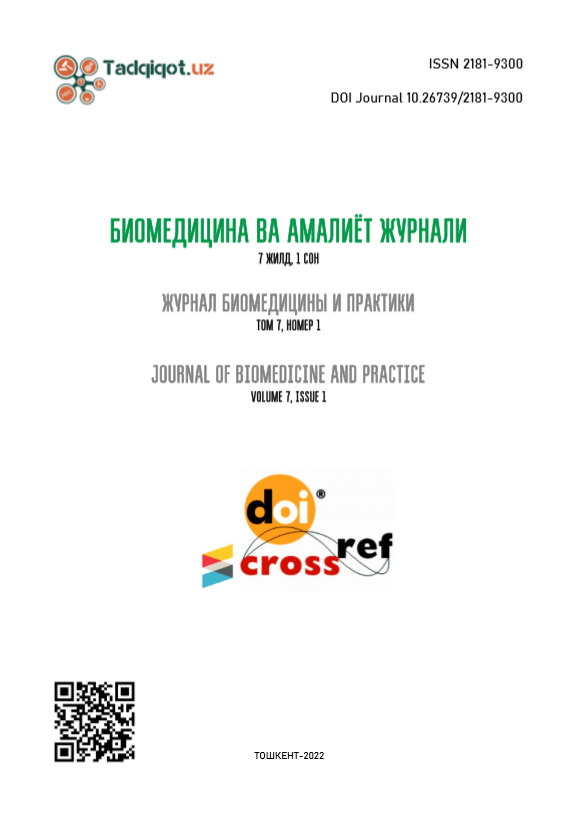MEDICAL ASPECTS OF PREVENTION OF MASSIVE BLEEDING AFTER CHILDBIRTH
Keywords:
cesarean section, postpartum bleeding, prevention, timing, blood loss, massive bleedingAbstract
Maternal mortality is an integrated indicator not only of the state of women's reproductive health, but also reflects the quality of medical care, its organization and provision. Obstetric bleeding continues to be one of the main causes of adverse birth outcomes. In recent years, special attention has been paid to the prevention of bleeding, the identification of risk groups for their occurrence. Protocols and clinical recommendations have been developed that reflect modern ideas about the pathogenesis, diagnosis and methods of treatment of this pathology. There is still the urgency of developing both conservative and operative methods of stopping bleeding in the early postpartum period. During the period of socio-economic changes taking place in Uzbekistan, issues of maternal and child health occupy one of the main places in the country's social policy.
References
Айламазян Э. К. и др. Аудит качества медицинской помощи при критических состояниях в акушерстве (near miss) //Журнал акушерства и женских болезней. – 2016. – Т. 65. – №. 4.
Асадов Д.А., Абдураимова Г.А., Бекбаулиева Г.Н. Социологической подход к антенатальной помощи// Назарий ва клиник тиббиёт. -2021. Том 1. №6. – С. 21-23.
Каримова Н.Н., Кличева О.О., Поянов О.Й.Оценка эффективности донатора оксида Азота при лечении дисфункции эндотелия у женщин, перенесших кровотечения в родах. Тиббиётда янги кун. -2021. №3 (35/1). – С. 416.
Макацария А. Д., Бицадзе В. О., Мищенко А. Л. Нарушения гемостаза и массивные послеродовые кровотечения //Акушерство, гинекология и репродукция. – 2014. – Т. 8. – №. 2.
Надырханова Н.С., Асатова М.М., Джалалов У.Ж. Этапы организации перинатальной помощи в Республики Узбекистан: текущая ситуация, прорблемы и пути их решения. Тиббиётда янги кун. -2021. №3 (35/1). – С. 15-18.
Bohlmann M. K., Rath W. Medical prevention and treatment of postpartum hemorrhage: a comparison of different guidelines //Archives of gynecology and obstetrics. – 2014. – Т. 289. – №. 3. – С. 555-567.
Dahlke J. D., Bhalwal A., Chauhan S. P. Obstetric emergencies: shoulder dystocia and postpartum hemorrhage //Obstetrics and Gynecology Clinics. – 2017. – Т. 44. – №. 2. – С. 231-243.
Diaz O. C. et al. Characteristics Associated with Early Follow-up in a “Low-Risk” Postpartum Population: A Postpartum Telephone Screening Program //American Journal of Obstetrics & Gynecology. – 2022. – Т. 226. – №. 1. – С. S106-S107.
Girard T., Mörtl M., Schlembach D. New approaches to obstetric hemorrhage: the postpartum hemorrhage consensus algorithm //Current Opinion in Anesthesiology. – 2014. – Т. 27. – №. 3. – С. 267-274.
Linde L. E. et al. Recurrence of postpartum hemorrhage, maternal and paternal contribution, and the effect of offspring birthweight and sex: a population-based cohort study //Archives of gynecology and obstetrics. – 2022. – С. 1-8.
Marshall A. L. et al. The impact of postpartum hemorrhage on hospital length of stay and inpatient mortality: a National Inpatient Sample–based analysis //American journal of obstetrics and gynecology. – 2017. – Т. 217. – №. 3. – С. 344. e1-344. e6.
Petrova N.G., Dodonova I.V., Pogosyan S.G., Okunev A.Yu., Bratclavsky V.B. Problems and experience of young specialists’ adaptation // Danish scientific J. – 2017. – vol. 32. – p. 25-28

